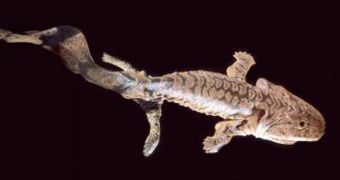Life on Earth did not experience a “booming” start, with countless species appearing at once, but rather gradually, with nature trying and failing several times over before finally coming up with viable organisms. Such was the case with the first creatures who got out of the seas, and attempted to walk on land. A reconstruction of such a beast shows exactly why evolution is good, and also why it takes place, as it's clearly visible that the pseudo-fish is not very well equipped for the task ahead, namely that of living outside the water. Now, a study from the University of Cambridge comes to show that the first land vertebrates – the tetrapods – were, in fact, more complex and diverse than first thought.
“Some looked like crocodiles, some looked like little lizards, some like moray eels, and some were snake-like. They occupied all sorts of niches and habitats. And they varied tremendously in size – from about 10 cm (4 inches) long to 5 meters (16 feet),” University of Cambridge Paleontologist Jennifer Clack, who conducted the new research, explains. She adds that these animals were roaming the shorelines around the world at a time when dinosaurs, birds and other mammals were still a thing of the distant future. It was only because of the tetrapods (Latin for four-legged) that dinosaurs could develop in such diversity, considering the fact that the first land vertebrates spread quickly in all manners of niches.
Enlisting the help of University of Oregon expert Charles Kimmel and Brian Sidlauskas, at the National Evolutionary Synthesis Center, in North Carolina, Clack set out to analyze the remains of some 35 types of identified tetrapods, which lived between 385 million and 275 million years ago, LiveScience reports. Because they didn't have the actual bodies of the animals in their possession, the team analyzed a region of the skull known as the palate, in order to determine the creatures' sizes. Their main hope was that this would allow them to draw a sketch of how the animal evolved over time.
“I tend to think the genetic instructions for making a skeleton come from how you make individual bones first, and then how you fit those bones together as a refinement of that,” Kimmel, who is a developmental biologist at the University of Oregon, shares. Sidlauskas underlines the fact that the investigation revealed “mismatches” in the way bones should have developed, and that this may explain how linages evolved from one to the next, differentiating into new species.
“Sometimes a change in size can have indirect consequences for the shape of the animal. When different parts of an animal's body change size at different rates over evolutionary time, that can generate changes in body shape from one species to another,” he says. “One of the big questions at the moment is: where did modern amphibians come from? One of the hypotheses is that they have evolved by paedomorphosis and miniaturization from early tetrapods. This study lends weight to that idea,” Clack concludes. A paper detailing the finds appears in the July 16th online edition of the Journal of Anatomy.

 14 DAY TRIAL //
14 DAY TRIAL //